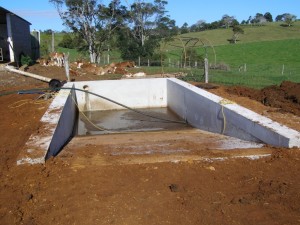Prior to 2007 most of the Group’s activities were focused towards on-ground projects which were mainly small in nature ($1-10,000), however with the signing of the Ten Year Funding Agreement LBCCG began delivering large-scale projects ($10-100,000) which aim to effect significant change in the quality of water entering Lake Baroon. Whilst this is very important for LBCCG, it also provides unique opportunities for landholders in the catchment to undertake larger scale projects. Since the signing of the Contribution Agreement, LBCCG has delivered Seqwater Catchment Improvement Programs (SCIP), which target specific issues – currently Landslides, Priority Weeds and Dairying.
In an ideal world, all waterways in the Lake Baroon catchment would be rehabilitated to provide riparian buffers, lower in-stream temperatures and provide suitable habitat for aquatic ecology. However the limited resources available means the catchment must be prioritised into areas where the greatest gains can be achieved through the smallest investment. We cannot realistically completely restore cleared riparian zones to pre-European conditions, but we can improve the ability of the zone to maintain the quality of water delivered downstream.
An estimated 80% of sediment and 35% of nitrogen in the waterways in south east Queensland comes from non-urban diffuse loads; sources such as unmanaged livestock grazing. Reduction of these loads clearly represents a major target for action if significant improvements in water quality are to be achieved in South East Queensland (DERM 2010).
LBCCG implements projects that deliver water quality benefits. At the same time good land management equals good water quality outcomes. With this in mind we implement the following types of projects (but not limited to):
Dairy Laneway Rehabilitation
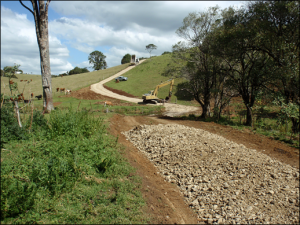
Poorly designed or constructed laneways on dairy farms are prone to erosion. The farm environment is greatly improved by hardening laneways, not only because erosion is minimised but also cows tend to move faster between paddock and dairy resulting in less manure deposited on laneways and therefore reduces the risk of faecal material entering drainage lines and watercourses.
Rehabilitated laneways significantly reduce erosion in high stock traffic areas resulting in less sediment run-off. Carefully designed laneways are shaped with strategic cross drainage (whoa-boys) to shed water to the sides (onto pasture) and direct run-off contaminated with faecal material (nutrients) to pasture that can trap and filter nutrients, rather depositing directly to watercourses.
Mud from boggy laneways pose health risks for the dairy herd and for raw milk and must be washed from udders before milking, requiring increased labour and water use. Boggy laneways increase the time taken (and energy expended) to travel between the paddock and dairy (for cows and vehicles). Poor access to grazing pastures, particularly during wet periods, limits efficient pasture use which can have a detrimental effect on run-off (overgrazed paddocks increase nutrient and sediment run-off).
Mastitis (and other bacterial infections) can be significantly reduced when dairy cows have reduced contact with mud and contaminated water (such as natural water bodies). Mastitis in dairy cattle is the persistent, inflammatory reaction of the udder tissue. Milk from cows suffering from mastitis has an increased somatic cell count and usually occurs in response to bacteria invading the teat canal.
Revegetation
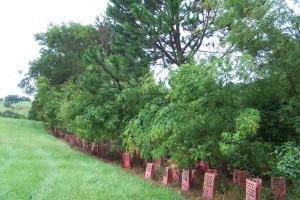
A healthy aquatic ecosystem is stable and sustainable; maintaining its physical complexity, biodiversity and resilience. It has the ability to provide ecosystem services that in turn contributes to good water quality, wildlife habitat and recreation.
Riparian areas are the transition zones between land and water environments. They are generally more productive in terms of total biomass than the adjoining area (which contributes to their clearing) and are critical for biological diversity. The protection, enhancement and rehabilitation of riparian zones is essential for sustainable catchment management and reducing risks to water quality.
Buffer strips provide a strip of vegetation that acts as a filter for sediment. They are designed to remove sediment, organic material, nutrients and chemicals carried in run-off. Buffer strips include both vegetative filters adjacent to agricultural land and riparian zones that maintain bank and channel stability.
Riparian Fencing
Livestock grazing is a land use that has the potential to alter the condition of a stream and riparian area if not managed properly. Improper livestock use of riparian areas can negatively affect riparian areas by changing, reducing or eliminating the vegetation within them.
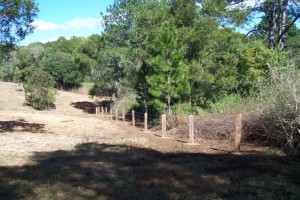
The direct effects of improperly managed livestock grazing on riparian vegetation include:
- change, reduce, or eliminate vegetation;
- decrease the vigour, biomass and alter species composition and diversity;
- change the channel morphology by widening and shallowing of the streambed;
- alter the stream channel through trenching or braiding depending on soil and substrate composition;
- alter the water column by increasing water temperatures, nutrients, suspended sediments and bacterial counts;
- alter the timing and volume of water flow;
- cause bank sloughing leading to accelerated sedimentation and erosion; and
- decrease wildlife habitat and species.
However when tightly controlled, fencing can be an invaluable, and sometimes essential tool to manage grazing in riparian zones whether permanent exclusion or managed grazed is performed.
The effectiveness of a riparian buffer to provide multiple environmental and water quality benefits varies depending on several key factors, namely bank slope, vegetation species composition and age, and soil type. Slope gradient appears to be the most important variable in removal of sediment or particulate pollutants, whereas buffer width is most important for the effective removal of dissolved nutrients (Barwick et al 2009).
Riparian buffers comprising grassed buffer strips are effective at trapping sediments and nutrients adsorbed to sediments (such as phosphorus), but tend to be relatively poor at trapping dissolved nutrients, or for the provision of shade, food sources, in-stream structure or corridors for many species. Riparian buffers comprising taller, woody vegetation are typically good at providing shade, as a source of food and woody habitats, as a screen for light and noise, as corridors for terrestrial fauna (to a varying extent depending on species composition), and as a means for reducing soluble nutrient inputs. Designed riparian buffers usually incorporate multi-tiered systems of both native woody vegetation to enhance ecological function, and vegetated filter strips for the management of water quality. In essence, this approach seeks to mimic the complexity and effectiveness of a natural riparian buffer system, and often the best approach is to provide the required buffer width to enable a self-sustaining buffer of native vegetation (Barwick et al, 2009).
Off Stream Watering
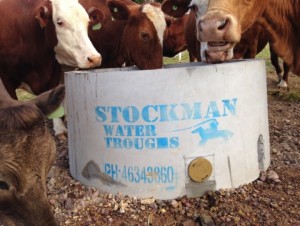
In the sub-tropics, the majority of overland flow events occur during the summer to early autumn period. Conversely during the winter and spring months, most faecal contamination in water channels occurs from an animal defecating directly into the water. Any practice that reduces the amount of time cattle spend in a stream will therefore reduce the manure loading and decrease the potential for adverse effects on water from grazing livestock.
Even without exclusion fencing of riparian zones, off-stream water sources reduce the amount of time free ranging cattle spend in or immediately adjacent to watercourses. Cattle prefer to drink from a trough over other sources of water available to them, resulting in a significant reduction in time spent in the stream (watering) and adjacent stream side area (grazing and loafing). Studies in North America have shown that following the installation of the off-stream watering (OSW) infrastructure, stream bank erosion decreased by 77% and concentrations of total suspended solids, total nitrogen and total phosphorous decreased by 90, 54 and 81% respectively (Sheffield et al, in McIver 2004). More recent studies indicate that although the installation of OSW by itself is effective, providing livestock supplements and shade near troughs reduced riparian zone pressures even further (Ganskopp 2001, McInnis and McIver 2001, Porath et al. 2002 in McIver 2004). Porath et al. (2002) also found that the provision of supplements increased weight gain in cows and calves.
Cattle when drinking at streams and dams enter the water to reduce bending; resulting in the stirring up of suspended solids (turbidity), and riparian zones can be difficult places for livestock to access (steep, muddy or rocky banks) placing greater effort and stress on individual animals. Additionally when cattle enter a water source they tend to defecate directly into the water body (pers. comm. Colin Cork). Troughs provide a level, relatively dry watering point where the animal does not have to bend excessively, reducing stress by providing improved footing, increased visibility and reduced physical effort. This is likely to lead to healthier animals with less risk of injury.
Cattle use riparian areas for resources other than water – crossing points, forage, shade, grooming sites (scratching posts) and general loafing. A well designed OSW system needs to take into account all these factors. Research by Gillen et al 1984 (in McIver 2004) shows that cattle prefer to graze within 200 metres of water. Therefore to optimise uniform grazing and water efficiencies, cattle should not have to walk more than 200 – 300 metres to water.
Season and time of day also have an effect on the effectiveness of an off-stream water source in reducing degradation to riparian areas. In the warmer months, riparian areas give shade and protection from the heat and the coolness of the water often draws the animals to the water’s edge. It is essential to ensure that alternative shade is provided within the paddock – preferably near the OSW trough and ideally on a high point exposed to cooling breezes.
Waterway Crossings
Formalised crossings protect livestock and the river from the problems associated with unrestricted access. The benefits include (Water and Rivers Commission 2000):
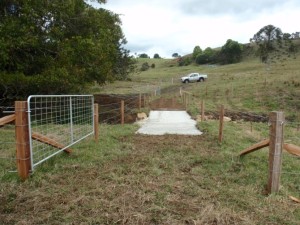
- improved water quality by limiting sedimentation and nutrient enrichment;
- enhanced livestock health through access to cleaner water;
- reduced loss of productive land and livestock deaths;
- provision of a relatively cheap option for providing livestock watering;
- maintaining river pools to provide a water source that is available for longer periods of year;
- stabilisation of the river banks and bed; and
- improved riparian vegetation and riverine habitats.
Crossings can be designed to provide many other ecological benefits such as (Water and Rivers Commission 2000):
- having a riffling effect which aerates the water and provides a variety of riverine micro-habitats;
- allowing for fish passage;
- maintaining river pools that are important in providing summer refuges and breeding areas for certain aquatic animal species, such as crayfish; and
- contributing to channel stability by controlling the velocity of flow and reducing the downstream movement of sediments into the river.
Installation of a stream crossing will improve water quality, reducing nutrient, sediment, pathogen, and organic matter loads to streams. A formal crossing will also reduce streambank and streambed erosion. Stream crossings can provide cattle with improved access to pastures thereby improving grazing distribution while reducing the likelihood that cattle will be injured. Stream crossings also improve vehicle access for weed management, pasture improvement, erosion management and other activities that influence the quality of water flowing off properties. Stable stream crossings can help prevent farm equipment damage by providing a smooth entrance and exit.
A good crossing is one that serves the purpose for a long time and requires minimal maintenance. The design must allow for a range of flow conditions and sustain as little damage as possible when flooding occurs. It is also essential to ensure that the crossing will have negligible environmental impacts.
Other than providing access across a stream for people, vehicles and livestock, a well-designed crossing provides environmental benefits. Restricting crossings to one point will greatly reduce local erosion and protect riparian vegetation from stock; further stabilising stream banks, and can greatly assist in managing nutrient input to the stream system. The overall benefits include reduced sedimentation, improved water quality, creation of shelter belts for stock and habitat for native wildlife (Janicke & Murray 2008).
Weed Management
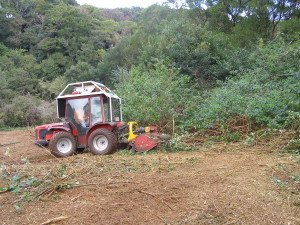
Major environmental weeds pose a serious and immediate threat to native vegetation and water quality due to their ability to alter the structure and composition of plant communities. Species such as small leaf privet can thrive in low-light conditions and over time will dominate riparian zones, out-competing native species and effectively developing mono-culture systems. Similarly lantana and blackberry form dense thickets. Natural regeneration is reduced below sustainable levels and only mature individual native flora species persist.
Vine species such as Blue morning glory, Madeira vine and Cats Claw vine, although requiring high light levels (and therefore not a major threat to robust remnant vegetation) spreads vegetatively and rapidly envelopes all other vegetation, and in time will kill those plants simply through the elimination of light and smothering. Vines rapidly form a mono-culture ground cover – even out-competing exotic pasture grasses. Although vines densely cover ground surfaces, they tend to be weakly-rooted and do not protect the ground surface from erosion during heavy rainfall events and high creek flows. Similarly they do not provide an effective buffer to overland flows and will not filter sediments and nutrients effectively.
Drainage (Landslip Remediation)
The presence of water within a rocky hillside is one of the major factors leading to instability and subsequent slipping. Hoek and Bray (1981) suggest that it is not necessarily the amount of water that activates land slips but rather the pressure brought to bear by the water, and propose three principles need to be taken into account to improve the stability of circumspect hill slopes:
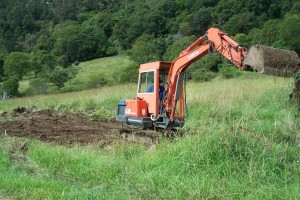
- Prevent water entering the hill slope through open cracks;Reducing water pressure in the vicinity of potential breakage surfaces through selective shallow and sub-shallow drainage; and
- Placing drainage in order to reduce water pressure in the immediate vicinity of the hillside.
Shallow drainage work has the main function of intercepting surface runoff water and keeping it away from potentially unstable areas. In reality, on rocky hillsides this type of measure although contributing to reducing the amount of infiltration, alone is insufficient to stabilise a hillside. Deep drainage is the most effective with this type of slope. Sub horizontal drainage is very effective in reducing pore-pressure along crack surfaces or potential breakage surfaces. Only by intercepting the mostly drained discontinuities can there be an efficient result. The sub horizontal drains are accompanied by surficial collectors which gather the water and take it away through networks of small surface channels.
Drainage improvements may often be the most cost-effective means of reducing the likelihood of landslides. They may include simple measures such as inspecting and repairing existing drainage systems or directing runoff to safe areas. Drainage measures can also be more complex, requiring the drilling of wells and installation of pumps to lower groundwater levels (Dept of Ecology).
Groundwater is a major factor in both shallow and deep land sliding, but is much harder to control than surface water. Shallow groundwater, which typically flows several feet below the ground surface, can often be captured with a trench or interception drain. Such systems need to be designed and constructed carefully and require regular inspection and maintenance. Collected water must be directed to a safe location (Dept of Ecology).
Revegetation Maintenance
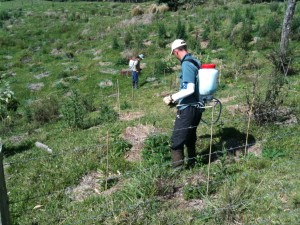
Good maintenance is an extremely important component of re-establishing vegetation particularly within the first 3 years of planting. Weed growth is very rapid on the Maleny plateau – particularly over the summer months where maintenance must be performed every six weeks. Failure to do so can result in plant mortality, weed infestation and frustrating labour – all of which results in excessive costs to ‘re-capture’ the site.
It is desirable, if not essential, to employ specialists who have the equipment, skills and knowledge to successfully manage revegetation sites and ultimately establish a functioning buffer. Landholders are rarely capable of managing all the maintenance required on large revegetation sites (more than 500 plants) and therefore in an effort to ensure success, LBCCG provides the bulk of support for maintenance. Contractors are selected on their experience, value for money, landholder engagement skills and landholder preferences.
Grass is maintained between the rows of revegetation to reduce erosion and to act as a filter – trapping sediments and nutrients during high rainfall events. Glyphosate herbicide is sprayed immediately around the ‘Plant-Pink’ guards reducing competition whilst weed mats placed under the guards minimises weed growth inside the guard. The grass between the rows is occasionally slashed so that access is maintained and the site does not become over-grown.
Dairy Effluent Management
Dairy shed effluent can contain:
- manure
- urine
- gravel/sand
- waste feed
- milk spillages
- detergent/disinfectant residue
- veterinary chemicals
- pathogens (bacteria, viruses, helminths etc)
Clearly the effective capture and management of dairy effluent is not only beneficial to the overall health of the dairy herd but efficiently treating the waste before it is released to the environment and waterways is critical. Traditional dairy effluent management techniques have centred on disposal on sacrifice paddocks or treating it in a two pond system to collect solids and reduce its strength. This is particularly so in the Lake Baroon catchment where high rainfall events complicate storage and use.
Improved understanding, rising input costs (fertiliser) and increasing environmental awareness has seen a shift from a perception of ‘waste’ to a resource utilisation approach. Importantly for Maleny Dairies is the ‘clean and green’ marketing of its products.
Effluent management can provide the benefits:
- reduced fertiliser costs;
- improve soil condition;
- improve soil moisture holding capacity (addition of organic material);
- improve nutrient holding capacity (addition of organic material);
- productivity gains through improved pasture growth (health and speed of growth).
Cow manure is rich in nutrients and organic material and is highly beneficial as a fertiliser and soil conditioner (provided it is not deposited/spread directly adjacent to waterways). Hard surfaces (concrete) within and around the dairy shed enables effluent to be captured, solids separated (to supplement purchased fertiliser) and the treatment of the water to a standard that poses no significant health risks for livestock or those that work and live on the farm and utilised in irrigation.
The most satisfactory soils for efficient and safe irrigation are deep; well-structured and well drained ranging in texture from loam to clay loam. The Maleny Plateau soils are predominantly Red Ferrosols which are generally the most desirable.
